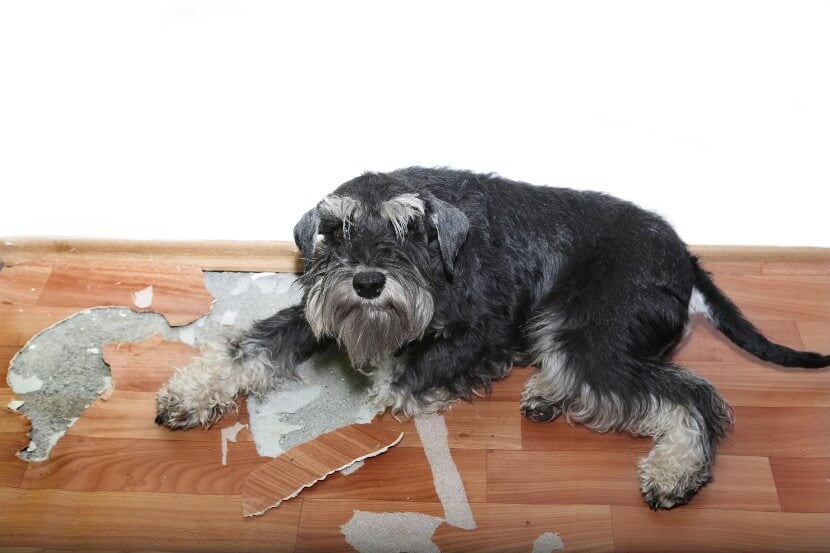Your standard home insurance is unlikely to cover pet damage. But it might be covered under an extended accidental damage policy.
If you want to avoid expensive repairs, you should try to train your pet to stop chewing or scratching your furniture.
We look at what type of home insurance you could get to cover pet damage. We’ll also give you tips to help you stop your pet from damaging your home.

Does home insurance cover pet damage?
Pet damage isn’t usually included on a standard home insurance policy.
But if you know your pet is prone to causing damage, an extended accidental damage policy could help. This usually covers damage such as:
- Chewing
- Scratching
- Staining the carpet
You’d also need to speak to your insurer to check exactly what it covers, as some policies might not cover every type of pet damage.
You might be covered if:
- Your dog knocks over a vase with their tail
- Your cat uses your TV as a climbing frame, knocks it to the floor and breaks it
Remember to always check with your insurer to see what exactly you’re covered for.
What if my dog damages someone else's property?
You can get third party cover as part of a pet insurance policy.
This usually covers you for the costs if your dog damages someone else’s belongings or property.
These policies can also provide cover for:
- Legal fees if your dog attacks someone
- Vet fees if they attack another animal
Does pet insurance cover damage to furniture?
Pet insurance doesn't normally cover damage to furniture. It’s there to cover your vet bills if your pet is ill or involved in an accident, not to protect your home and possessions.
Does having a pet increase my insurance premium?
Yes, having a pet will make your home insurance more expensive. This is because it increases your chances of making a claim. In fact, having a cat and a dog increases your insurance prices by over £25*:
| Cover type | No pets* | Cats* | Dogs* | Cats and dogs* |
|---|---|---|---|---|
|
Buildings
|
£123.94
|
£130.66
|
£126.56
|
£139.73
|
|
Buildings and contents
|
£148.98
|
£158.83
|
£161.16
|
£176.14
|
|
Contents
|
£55.15
|
£60.46
|
£63.43
|
£69.09
|
How can I pet-proof my home?
These methods should help to prevent your pet destroying your furniture:
- Get a throw for your sofa. This protects it from dog hair and drool marks. Lint rollers work well to clear up any rogue hairs, too.
- Set the boundaries. If you don’t want the dog or cat on the sofa, that’s fine. You can get them a snuggly bed to sleep in.
- Try a pen or a crate to keep your dog in one spot. You should make sure there’s enough room for them and put in toys to keep them occupied.
- Use a baby gate or 'dog stopper'. Baby gates are useful if you have a puppy as they can see you through the bars, and it might help reduce separation anxiety.
- Have a dedicated pet cleaning space. This should protect your floors after a muddy walk. Use your utility room if you have one or get the worst of the dirt off in the garden.
How can I stop my dog from chewing things?
Dogs usually chew because they’re bored or because they’re suffering from separation anxiety.
If your dog is bored, try getting puzzle toys, such as one that dispenses treats when your dog moves it. Flavoured chew toys also work well to keep your dog entertained.
Alleviating their boredom can stop them turning to wires, the carpet or anything else that feels good to chew. These tips might work for dogs that suffer from separation anxiety, too.
The RSPCA suggests using a ‘special toy’ that you bring out only when you leave. When you get back, store the special toy away until the next time you leave.
You could also try taking your dog for a walk about half an hour before you leave. When you get back from your walk, give it a small bowl of food. This might also encourage it to relax and stop chewing.
You shouldn’t be leaving your dog for more than 4 hours a day. If you do, it’s worth hiring a dog-sitter to keep it company and provide some stimulation.
How can I stop my puppy chewing things?
When puppies are teething, they might chew things to relieve irritation.
When you notice your puppy chewing something they shouldn’t be, make a loud noise – but don’t shout.
A squeak of a toy or a clicker should work. Once you have their attention give it a toy that they're allowed to chew. Once they start chewing this, give them a lot of praise.
How can I stop my cat from scratching my furniture?
To stop your cat scratching furniture or carpets, buy a couple of sturdy scratching posts. Or if you’re on a budget try laying out carpet off-cuts or even a sturdy piece of bark.
Place these in front of the piece of furniture that your cat likes to scratch.
For the scenting issue you could try using a spray such as Feliway. When it gets a nose-full, they’ll think they’ve already marked it and might leave it alone.
Why do cats scratch furniture?
Cats scratch to work out the muscles in their paws and along their back. Cats have scent glands in their paws, too. When they scratch, they mark their territory.
The aim of this is to keep other cats away – even if there's no other cat around.
Compare home insurance quotes
*Confused.com data. August 2022 - July 2023. Buildings, contents and combined home insurance policies.







